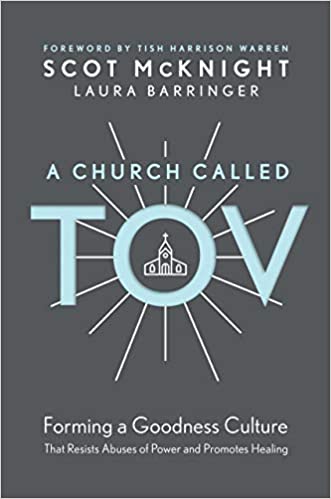Title: A Church Called Tov: Forming a Goodness Culture That Resists Abuses of Power and Promotes Healing
Authors: Scot McKnight and Laura Barringer
Publisher: Carol Stream IL: Tyndale House Publishers
Pages: 222 plus end notes
For those of us who have been a part of the white evangelical church for decades sex scandals and abuses of power are unfortunately nothing new. We lived through the 1980’s and the era of Jimmy Swaggart and Jim Bakker. However, this current moment is different. The confluence of social media, the broader #metoo movement with its centering of and listening to the victim, and a growing movement of white “ex-vangelicals”1 is pushing the white evangelical church toward questioning and hopefully true repentance and change. McKnight and Barringer seek to promote this repentance and lasting change in their 2020 book, A Church Called Tov: Forming a Goodness Culture That Resists Abuses of Power and Promotes Healing. They dedicate their work to “the wounded resisters” and provide a framework to create a tov (good) church culture rather than a toxic one in order to prevent further abuse.
In part one the authors walk the readers through the characteristics of toxic church cultures, helpfully beginning their discussing with the recognition that every church has a culture and it is created and nurtured, intentionally or unintentionally, by every member of a church, not just the leaders. They go on to identify warning signs of a toxic culture and tie concrete examples of abuse of women in the church in recent years to these characteristics. The writing is easily accessible and presented in a way that readers should easily be able to apply the material to their own ministry situations. McKnight and Barringer are very careful to document the situations of abuse they use as examples of toxic culture as well as the biblical and theological mandates those involved ignored (the footnotes throughout are extremely helpful). Though not the main focus of the book, this section paints a clear, concise, and appropriately disturbing picture of the behaviors and attitudes that contribute to toxic and deforming church cultures.
The authors see abuse in the church as a symptom of a larger spiritual problem, that is, a lack of tov being the primary virtue as the foundation for church culture. When churches seek the tov that produce the fruit of goodness, they can defeat the ra (evil) of abuse.
Part two, the bulk and crux of the book, is devoted to what the authors describe as the seven elements of a tov culture, that is, “The Circle of Tov.”2 The central theme of this model is the idea that tov, the Hebrew word for “good,” is “the Bible’s summary term, the ‘executive virtue,’ for how God wants us to live.”3 God’s goodness is seen in creation and expressed in the person of Jesus, demonstrating the active nature of tov. Thus the church, and its leaders, should be examples of this same goodness. The authors are essentially framing the issue of abuse in the church as a symptom of a larger spiritual problem, that is, a lack of tov being the primary virtue as the foundation for church culture. Rather than focusing on addressing symptoms of abuse the authors attempt to prevent abuse in the first place by helping churches understand the elements of tov that produce the fruit of goodness rather than the toxic elements of ra (evil) seen in the descriptions of abuse in part one.
There are seven elements in the authors’ proposed “circle of tov,” each a link in literal circular diagram so it is clear visually that if one essential habit is not present it will prevent a truly tov culture from being formed. In order to create a tov culture, McKnight and Barringer propose that churches: 1) nurture empathy, 2) nurture grace, 3) nurture a people-first culture, 4) nurture truth, 5) nurture justice, 6) nurture service, and 7) nurture Christlikeness. While these habits will presumably result in a tov church in every area of community life, the authors focus their helpful and concrete examples on how tov is seen through the treatment of women, particularly centering the voices of women who have been abused and creating spaces that are safe for those who have been historically marginalized. For pastors who have struggled to understand how situations of abuse went unheard for years these examples will provide a very practical application to the framework. McKnight and Barringer also do a very good job of clearly defining their terms, which is important given their use of sometimes controversial terms like “justice” and “empathy.” For example, their definition of “justice” is “behavior that measure up or confirms with God as revealed in Christ and the Scripture.”4 They explain their model clearly and compellingly and make their arguments citing not only real-life examples, but also grounding the entire model in a nuanced understanding of Scripture. McKnight’s credentials in particular will reassure readers that this model is based in solid biblical scholarship and not simply a knee-jerk response to current social issue. In fact, the book essentially calls the church back to a deeper understanding and practice of biblical principles which should naturally lead to tov rather than to the abuses that have been seen in the past decades. A tov church is the way that things were always supposed to be and the authors want to show the church how to get back to creating that kind of culture.
That said, for readers of the Journal of Urban Mission there will be some challenges in applying the very helpful model to an urban context. First, the authors repeatedly refer to “the church” and yet all of their examples of church cultures are from the white evangelical church, and particularly, a suburban church. Yet nowhere do the authors specifically identify that this is the expression of church to which they refer. To be fair, they do identify that they understand their examples refer to large churches but could easily be applied to small churches. However, as with many white evangelical authors, they do not clearly acknowledge their own positionality but rather assume themselves as normative for the term “church.” The work would have been strengthened and would, I believe, would be more widely received, had the authors chosen to identify “the church” as specifically the “white evangelical church” and allow (or even specifically ask) readers to contextualize appropriately. As it stands, it could leave non-White evangelical church members, or even non-evangelical Christians an “out” on these concepts, much in the same way that many Christians excused themselves from learning lessons from the Catholic Church abuse scandals because it was something that happened “to them” and not “to us.”
The authors do not clearly acknowledge their own positionality but rather assume themselves as normative for the term “church.” The work would have been strengthened had the authors chosen to identify “the church” as specifically the “white evangelical church” and allow (or even specifically ask) readers to contextualize appropriately.
Along those same lines, while there were many good, concrete examples of abuse, they were all taken from well-known scandals that happened in white, suburban, evangelical spaces. Does this mean that abuse is not taking place in non-White and/or urban spaces? Of course it, sadly, is. In fact, it only takes a cursory internet search to find examples of abuse in non-White and/or urban church spaces.5 However, the authors chose to limit their examples and thus limit the potential impact of their book, and their very helpful and scripturally sound model to white suburban spaces. I believe well-trained urban pastors will find the authors’ model extremely useful and will be able to easily contextualize the model to their own local space, and supply their own examples when discussing the model with their congregations. The theology and biblical references that underpin the model are deep, sound, and extremely relevant to any church context. However, if this book were used as a congregational study in a setting other than a white, suburban, evangelical church, I fear that the message would be lost on a typical parishioner, possibly leading them to the conclusion that abuse is an issue that happens to “those people over there” and not “to us folks over here.”
Notes
1 See Onishi, Bradley. “The Rise of #Exvangelical.” Religion & Politics (April 9, 2019). https://religionandpolitics.org/2019/04/09/the-rise-of-exvangelical/.
2 Page 80.
3 Page 87.
4 Page 167.
5 A book was written in 2012 by Donald H. Matthews entitled, Sexual Abuse of Power in the Black Church: Sexual Misconduct in African-American Churches (WestBow Press). While I have not read it, the fact that I could find it easily shows the disconnect between the discussion of abuse across different groups and the need to clearly define in this work what the authors mean by “the church.”

